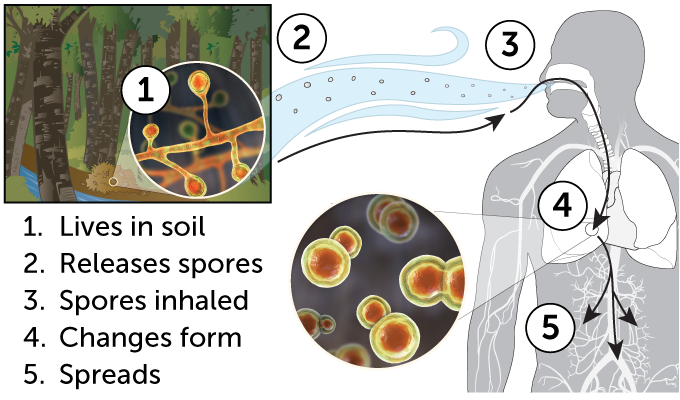Some fungi that can cause serious lung infections have spread to many parts of the United States. A Science News story on the expanded range of Histoplasma, Coccidioides and Blastomyces fungi hit a nerve with a lot of readers (SN: 1/4/22).
They asked about the symptoms, treatments and testing for these fungal diseases. Some, like Judy Knudsen, whose husband Jack died from a Histoplasma infection in 2020, also wrote to share their own experiences with fungal infections. Others wanted to learn more about the fungi themselves.
Science News headlines, in your inbox
Headlines and summaries of the latest Science News articles, delivered to your email inbox every Thursday.
Client key* E-mail Address* Sign up
Thank you for signing up!
There was a problem signing you up.
I went back to Andrej Spec, a mycologist and infectious diseases doctor at Washington University School of Medicine in St. Louis whose team published the new range maps, for answers.
Spec and his colleagues are studying what has caused the fungi to spread and factors that may contribute to people getting sick. Those include changes to climate, weather patterns, extreme weather events like wildfires and floods, and even migration patterns of animals.
How do you catch these fungal infections?
People generally get infected by inhaling fungal spores released during the fungi’s normal life cycle. Human activities that disturb the soil where these fungi typically live — such as farming, gardening, construction, road work or archaeology — can also stir up dust and spores.
Besides soil, bird droppings and bat guano can be sources for Histoplasma. The fungi can infect bats and grow in the animals’ intestines. Birds don’t usually carry the fungus because birds’ body temperatures are typically around 39° Celsius to 42° C (102° Fahrenheit to 107° F). “They’re too hot for Histo, but their droppings are perfectly suited to grow” the fungus, Spec says.
The highest risk to people comes when bird and bat droppings have dried out. “People will try and sweep [the droppings], and then you kick up all that dust and inhale it.” Instead of sweeping, Spec advises, “hose it down and shovel it off.”
Wearing a mask can also help limit exposure. “Especially if you’re immunosuppressed, wear a mask.”
Subscribe to Science News
Get great science journalism, from the most trusted source, delivered to your doorstep.
Subscribe
It is possible for the fungi to get into a cut or scrape and start an infection in the skin, but those cases are very rare, Spec says. And people generally can’t pass the infection on to others, except in very rare cases in which an infected person has donated an organ or other body tissue, he says.
What happens in the body?
These three types of fungi are known as dimorphic fungi because they have two forms. In the soil, where they normally grow, they are molds. But at 37° C — human body temperature — they shape-shift into yeast, which can grow rapidly and spread more easily in the body.
When a person inhales the fungal spores, the fungi can infect the lungs where conditions are right for it to transform. People with healthy immune systems may have no symptoms or may develop mild flulike symptoms, including fever, cough, fatigue, chills and body aches. People with coccidiomycosis — the disease caused by Coccidioides — may also get a rash on their legs or upper body.
How some fungi can make you sick
Histoplasma, Blastomyces and Coccidioides fungi live in the soil as molds. Sometimes people breathe in spores the fungi give off as part of their natural life cycle. In the lungs, the fungi can transform into a quick-growing yeast form and cause a flulike illness, pneumonia or chronic disease. In a small number of cases, the fungi can spread to other parts of the body and cause more serious disease.
 KATERYNA KON/SCIENCE PHOTO LIBRARY/Getty Images Plus, CDC; adapted by T. TibbittsKATERYNA KON/SCIENCE PHOTO LIBRARY/Getty Images Plus, CDC; adapted by T. Tibbitts
KATERYNA KON/SCIENCE PHOTO LIBRARY/Getty Images Plus, CDC; adapted by T. TibbittsKATERYNA KON/SCIENCE PHOTO LIBRARY/Getty Images Plus, CDC; adapted by T. Tibbitts
The symptoms can take time to appear. People with histoplasmosis — the disease caused by Histoplasma — can develop symptoms between three and 17 days after exposure. Symptoms of coccidiomycosis — also known as Valley Fever — appear between one and three weeks after breathing in the spores. But it can take three weeks to three months for blastomycosis — caused by Blastomyces — symptoms to start.
Mild cases usually clear up on their own in a few weeks to a few months. But some people may have lingering symptoms, especially if the infection becomes severe.
In 2019, more than 20,000 people in the United States were diagnosed with coccidiomycosis, 1,124 people had confirmed or probable cases of histoplasmosis and there were 240 cases of confirmed or probable blastomycosis, according to cases reported to the U.S. Centers for Disease Control and Prevention. That’s probably an undercount, given that mild cases likely aren’t reported and the infections can easily be misdiagnosed as more common lung diseases, the researchers say. But of the reported cases, more than half of people diagnosed with histoplasmosis and blastomycosis were hospitalized. About 5 percent of histoplasmosis patients died. So did 9 percent of those with blastomycosis.
Some people may develop severe or chronic pneumonia. And in a small number of people, the infections may spread to other parts of the body. Histoplasma “likes to go after our liver and spleen, our bone marrow … adrenal glands … and our intestines,” Spec says.
Blastomyces tends to spread to bones and joints. It may also spread to the brain where it can cause an abscess.
Coccidioides spreads in a pattern similar to Blastomyces, targeting bones, joints, skin and the brain. But instead of creating a brain abscess, the fungi cause meningitis, an inflammation of the membranes surrounding the brain and spinal cord.
“That’s with you forever if it spreads to your brain,” Spec says. “You can’t get rid of Cocci.” Doctors can manage the brain infection with antifungal drugs and give other medications to help with symptoms.
Antifungal drugs can clear most other infections. “If caught early, most people do exceedingly well,” he says.
Warning signs
Symptoms of all three fungal diseases caused by Histoplasma, Coccidioides and Blastomyces fungi are similar and can resemble the flu or other lung infections. Signs of a fungal lung infection may include:
- Fever
- Cough
- Fatigue
- Chest pain or discomfort
- Weight loss
- Headache
- Chills
- Muscle or joint pain or body aches
- Shortness of breath
- Night sweats for people with Blastomyces or Coccidioides infections
Who is most affected by these fungal infections?
People who have weakened immune systems are more likely to develop symptoms and severe disease.
And fungal infections and severe disease occur more often in men than women. About 70 percent of Blastomyces infections, 52 percent of Coccidioides cases and 56 percent of Histoplasma infections were in males, the 2019 CDC survey found.
Why males are more affected isn’t entirely clear. Some people have speculated that men tend to have more outdoor jobs and hobbies that would expose them to dirt and thus more fungi.
It’s not clear how Jack Knudsen became infected. “We have no earthly idea why this came up,” says Judy, 82, of Oklahoma City. Already battling chronic lymphocytic leukemia, heart problems and diabetes, Jack’s immune system wasn’t up to tackling the fungus. “He struggled,” she says.
He spent two weeks in the hospital getting antifungal drugs intravenously. He also took four doses a day of a liquid antifungal medication called itraconazole for the rest of his life. He died on January 23, 2020, at age 79. “We had 61 good years together,” Judy says.
There may be biological reasons for the male-female skew. A recent study of coccidiomycosis found that the sex difference was also present in nonhuman primates and in dogs. “There’s very little difference between occupational exposures and hobbies between male and female” animals, says Spec, who was not involved in that study.
The researchers found no difference in infection rates in humans up to age 19. After that, the infection rate for males held steady. But female’s infection rate dropped, Ian McHardy, a microbiologist and immunologist at Scripps Health in San Diego, and colleagues reported in the March 2022 Open Forum Infectious Diseases. That might mean that estrogen and other hormones that are usually at higher levels in females may protect against fungal infections. But that link is still speculation.
Fungi that cause serious lung infections are now found throughout the U.S
 Roger Harris/Science Photo Library/Getty
Roger Harris/Science Photo Library/Getty
See how the ranges of Histoplasma, Blastomyces and Coccidioides have changed in the United States from 1950 to today.
Curiously, people of Filipino or African heritage may be at increased risk of developing more severe forms of Valley Fever. The reason is unknown. Other people, including those who are pregnant, living with HIV/AIDS or who have weakened immune systems from other causes are also at higher risk of more severe disease from all three fungi. So are people with diabetes and those who are older.
How can I find out if my infection is caused by a fungus?
Because symptoms of the fungal infections so closely resemble other illnesses, it can be hard to diagnose fungal disease, Spec says.
Jack Knudsen started having seizures in 2018, Judy says. At first, doctors thought he had epilepsy, but medications to treat the disorder had no effect. When one side of his face began to droop, an MRI and other tests revealed that Jack had Histoplasma in his brain. “I had never heard of it in my life,” says Judy, who said she wanted to share her husband’s story to make people more aware of the disease.
Blood or urine tests can be used to diagnose a fungal infection. Chest X-rays or CT scans may also be used. In some cases, doctors may need take a small amount of body tissue or fluids to test for the fungi.
“A lot of people who think they have [a fungal infection] are probably going not to have it.” Spec says. “It’s a disease that is certainly more common than people think but is still relatively rare.” The new maps Spec and colleagues compiled may make doctors and other people more aware that the fungal diseases may be present where they live.
People who are concerned that they may have a fungal infection can visit mycoses.org where Spec and colleagues have assembled interactive maps showing where the fungi are found. “You’ll be able to see [based on] where you live which one you’re at risk for. When you have that data, your best goal is to talk to a doctor for testing.”
Any doctor can order a test, but infectious diseases specialists may have more expertise with the fungal diseases, he says.

